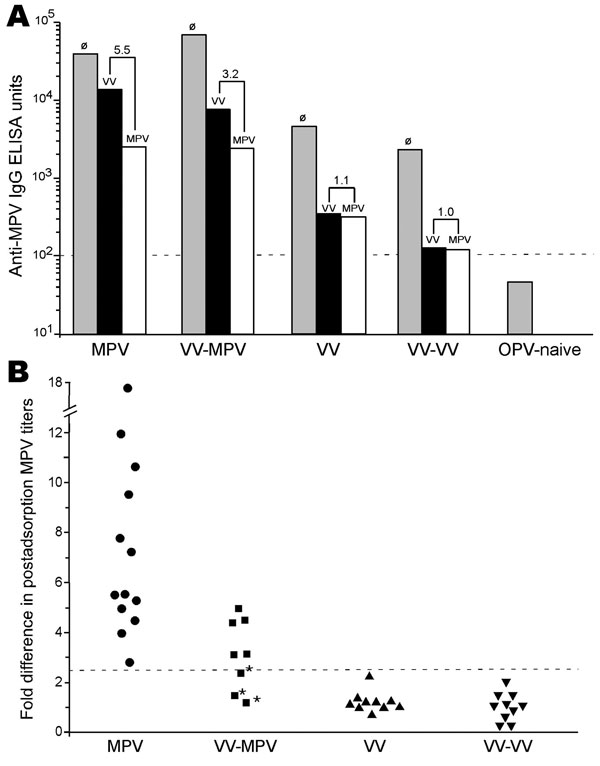Volume 14, Number 4—April 2008
Research
Retrospective Analysis of Monkeypox Infection
Figure 1

Figure 1. Diagnosis of monkeypox by postadsorption ELISA. Plasma samples were obtained from monkeypox-immune persons (2–30 months postinfection), vaccinia-immune persons (2–4 months postinfection), or uninfected orthopoxvirus-naive persons and tested on ELISA plates coated with inactivated monkeypox antigen. A) A representative monkeypox-specific ELISA with plasma samples from an unvaccinated monkeypox-infected person (MPV), a previously vaccinated (i.e., vaccinia-immune) monkeypox-infected person (VV-MPV), a vaccinia-immune person (VV), a vaccinia-immune person who was revaccinated with vaccinia (VV-VV), and an uninfected orthopoxvirus-naive person (OPV-naive). Plasma was not preadsorbed (∅, gray bars), preadsorbed with inactivated vaccinia antigen (black bars), or preadsorbed with inactivated monkeypox antigen (white bars) before ELISA on monkeypox-coated plates. Numbers above bars refer to differences in postadsorption MPV ELISA titers after adsorption with vaccinia antigen compared with adsorption with monkeypox antigen. Plasma from 1 orthopoxvirus-naive person (representative of n = 12) was not preadsorbed with viral antigen because it was seronegative (<100 ELISA units) and below our detection limit (dashed horizontal line). B) Plasma samples from monkeypox-infected persons (•, n = 13), vaccinia-immune monkeypox-infected persons (■, n = 8), vaccinia-immune persons (▲, n = 10), and revaccinated vaccinia-immune persons (▼, n = 10) were tested by postadsorption ELISA. Data show fold-differences of monkeypox antibody titers after adsorption with vaccinia antigen compared with adsorption with monkeypox antigen. Dashed horizontal line indicates a diagnostic cutoff indicative of a positive result, which was determined as a postadsorption difference score of >2.5. *Denotes results of plasma samples obtained from persons with clinically inapparent monkeypox infection.